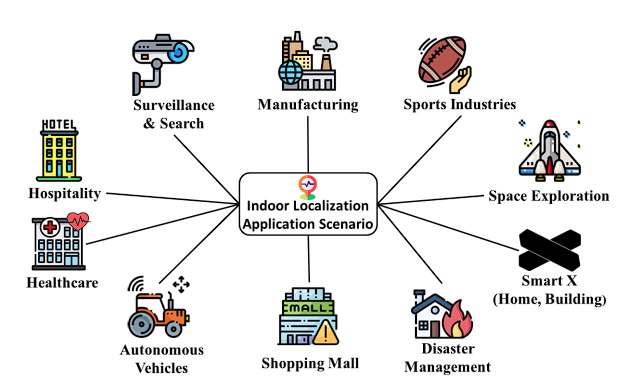Naji graduate in Indoor Positioning System
Indoor Positioning Using Wi-Fi Fingerprinting
Author: Mohammad Amin Naji Meidani
Supervisor: Prof. Hadi Sadoghi Yazdi
Email: mohammadamin.najimeidani@mail.um.ac.ir
Introduction
Applications of Indoor Positioning
Today, most outdoor positioning systems rely on satellites and are based on the Global Positioning System (GPS). These systems are highly accurate for outdoor navigation but struggle with precise indoor positioning due to weakened satellite signals inside buildings. To address this issue, new technologies known as indoor positioning systems (IPS) have been developed. IPS is widely used in places like schools, offices, supermarkets, hospitals, and universities. For example, in supermarkets, shoppers can use a shopping cart with a digital guide screen and RFID tags to locate products. In museums, visitors can use Bluetooth and Wi-Fi devices to find information about exhibits. IPS can also assist students in finding specific shelves in a library and is used in targeted marketing, where advertisements are tailored to individuals’ preferences and locations within a building, such as sending clothing ads to those frequently visiting clothing stores.
Problem Statement and Research Motivation
One of the main challenges faced by visitors to large buildings such as offices, hospitals, stores, and universities is confusion and difficulty in finding the optimal route to their desired location. This issue leads to significant time and energy waste for both visitors and staff. Hence, there is a need for a system to guide visitors to their destinations. The focus of this research is to develop a ubiquitous and non-specialized indoor positioning system. The system should utilize existing infrastructure without requiring additional infrastructure or high costs for implementation. The aim is to create a prototype of an indoor positioning system based on mobile phones. The Faculty of Engineering at Ferdowsi University of Mashhad has been selected as the test environment, where the system will leverage the faculty’s Wi-Fi access points for positioning.

System Overview
The contributions of this thesis are divided into two sections: software related and machine learning. In the software section, the map of the Faculty of Engineering was first converted from the proprietary AutoCAD format to the GeoJSON format, which is an open-source format that can be used in applications. Then, an Android app was developed using the Flutter platform, responsible for recording Wi-Fi signals and displaying the predicted location on the map. The collected data is stored in a database on the server side, and the machine learning operations are also performed on the server. In the machine learning section, the fingerprinting method was used for positioning. In the offline phase, the data is cleaned and preprocessed, then stored in the database. To examine the effect of the number of reference points on positioning accuracy, Gaussian process regression was employed to enrich the offline phase data. In the online phase, a buffering mechanism was introduced to achieve less noisy and more reliable responses. The weighted k-nearest neighbors (k-NN) algorithm was used to predict the final location. Additionally, the impact of different distance metrics on prediction accuracy was investigated.
Enjoy Reading This Article?
Here are some more articles you might like to read next: